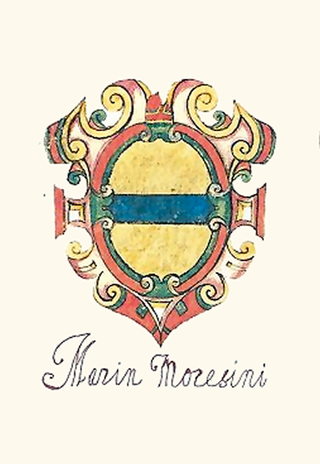Related Research Articles

Enrico Dandolo was the Doge of Venice from 1192 until his death. He is remembered for his avowed piety, longevity, and shrewdness, and is known for his role in the Fourth Crusade and the Sack of Constantinople. Dandolo died in 1205 in Constantinople and was buried at the Hagia Sophia.

The Patriarch of Venice is the ordinary bishop of the Archdiocese of Venice. The bishop is one of the few patriarchs in the Latin Church of the Catholic Church. Presently, the only advantage of this purely formal title is the bishop's place of honor in papal processions. In the case of Venice, an additional privilege allows the patriarch, even if he is not a cardinal, the use of the colour red in non-liturgical vestments. In that case, the red biretta is topped by a tuft, as is the custom with other bishops who are not cardinals.

This is a list of the Patriarchs of Grado.

Marcello Tegalliano was, according to tradition, the second Doge of Venice (717–726). He is described as having hailed from Eraclea, and during his nine-year reign was apparently in great disagreement with the nearby Longobards. He died in 726 and was succeeded by Orso Ipato.

Agnello Participazio was the tenth traditional and eighth (historical) doge of the Duchy of Venetia from 811 to 827. He was born to a rich merchant family from Heraclea and was one of the earliest settlers in the Rivoalto group of islands. His family had provided a number of tribuni militum of Rivoalto. He owned property near the Church of Santi Apostoli. A building in the nearby Campiello del Cason was the residence of the tribunes. Agnello was married to the dogaressa Elena.

Otto Orseolo was the Doge of Venice from 1008 to 1026. He was the third son of Pietro II Orseolo and Maria Candiano, whom he succeeded at the age of sixteen, becoming the youngest doge in Venetian history.

Domenico Morosini was the thirty-seventh doge of the Republic of Venice, reigning from 1148 until his death in 1156.

Pietro Polani was the 36th Doge of Venice. He reigned from 1130 to 1148.

The Italian Catholic Diocese of Chioggia is in the Veneto, at the southernmost point of the Laguna veneta. Until 1451, the diocese was a suffragan of the Patriarchate of Grado. On 8 October 1451, in the bull "Regis Aeterni", Pope Nicholas V abolished the patriarchate of Grado, and transferred its powers and privileges to the Archdiocese of Venice. Since then, Chioggia has been a suffragan of Venice.
This article presents a detailed timeline of the history of the Republic of Venice from its legendary foundation to its collapse under the efforts of Napoleon.
Isola di San Clemente is a small island in the Venetian Lagoon in Italy. For centuries it housed a monastic settlement, and more recently an asylum. It is now the site of a luxury hotel.
The Church of San Clemente is a church built in 1131 and located on San Clemente Island, in the Venetian Lagoon. The name is dedicated to Pope Clement I, who died as a martyr according to legend and who is patron of seamen.

The Diocese of Castello, originally the Diocese of Olivolo, is a former Roman Catholic diocese that was based on the city of Venice in Italy. It was established in 774, covering the islands that are now occupied by Venice. Throughout its existence there was tension between the diocese, the Patriarchate of Grado to which it was nominally subordinate, and the Doge of Venice. Eventually in 1451 the diocese and the patriarchate were merged to form the Archdiocese of Venice.
Enrico Contarini was a Venetian priest who was Bishop of Castello from 1074 to 1108.
Enrico Dandolo was Patriarch of Grado, Italy, from 1134 to 1182. A member of a noble Venetian Dandolo family, after his appointment he put the interests of the church ahead of all other concerns.
Enrico Dandolo may refer to:

Ulrich II von Treven was Patriarch of Aquileia in northern Italy from 1161 to 1181. He supported Frederick I, Holy Roman Emperor, (1122–1190) in his unsuccessful struggle for supremacy over the northern Italian states and the papacy. He was also involved in a dispute over jurisdiction with the Patriarch of Grado where he was ultimately successful.
Events during the year 1100 in Italy.

The House of Dandolo was a patrician family of the Republic of Venice, which produced four Doges of Venice. The progenitor of the family was a merchant named Domenico. The family became more successful by the beginning of the 12th century.
This is an alphabetical index of people, places, things, and concepts related to or originating from the Republic of Venice. Feel free to add more, and create missing pages.
References
Notes
- ↑ Enrico Dandolo, appointed Patriarch of Grado around 1134, was the uncle of the famous Doge of Venice, also called Enrico Dandolo. [1]
Citations
- 1 2 Madden 2008, p. 24.
- 1 2 Cheney 2013.
- 1 2 3 Madden 2008, p. 26.
- ↑ Sammartini & Resini 2002, p. 221.
- 1 2 3 Madden 2008, p. 27.
- 1 2 Carraro 2012, p. 47.
- ↑ Madden 2008, p. 25.
- ↑ Madden 2008, p. 28.
- ↑ Madden 2008, p. 36.
Sources
- Carraro, Silvia (2012). "Tra sacro e quotidiano. Il monachesimo femminile nella laguna di Venezia in epoca medievale (secoli IX-XIV)" (PDF). Retrieved 2013-11-24.
- Cheney, David M. (2013). "Bishop Giovanni Polani". Catholic Hierarchy. Retrieved 2013-11-23.
- Madden, Thomas F. (2008-04-01). Enrico Dandolo and the Rise of Venice. JHU Press. ISBN 978-0-8018-9184-7 . Retrieved 2013-11-23.
- Sammartini, Tudy; Resini, Daniele (September 2002). Venice from the bell towers. Merrell. ISBN 9781858941851 . Retrieved 2013-11-24.